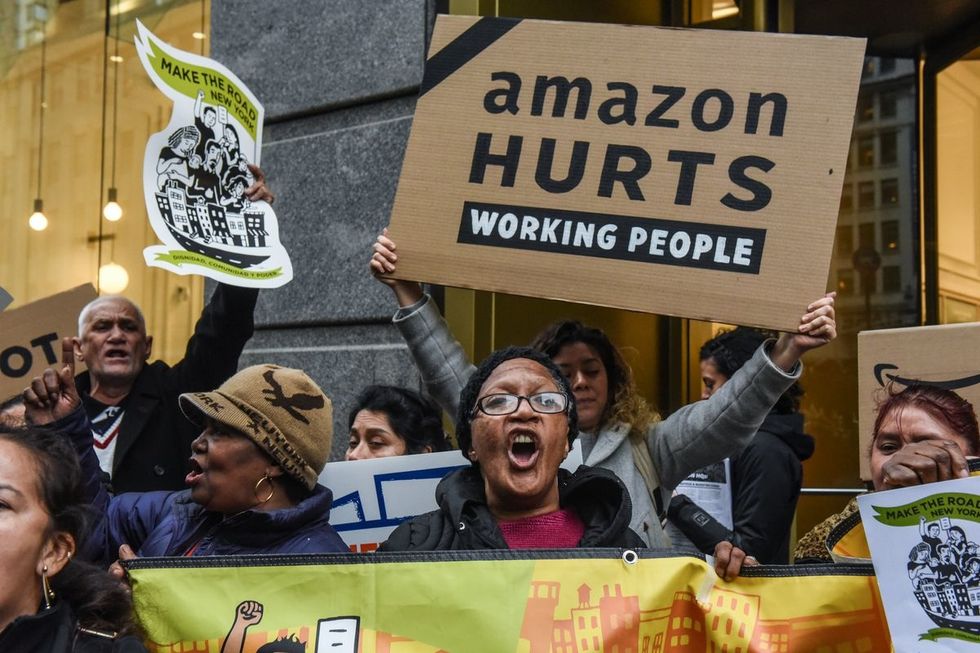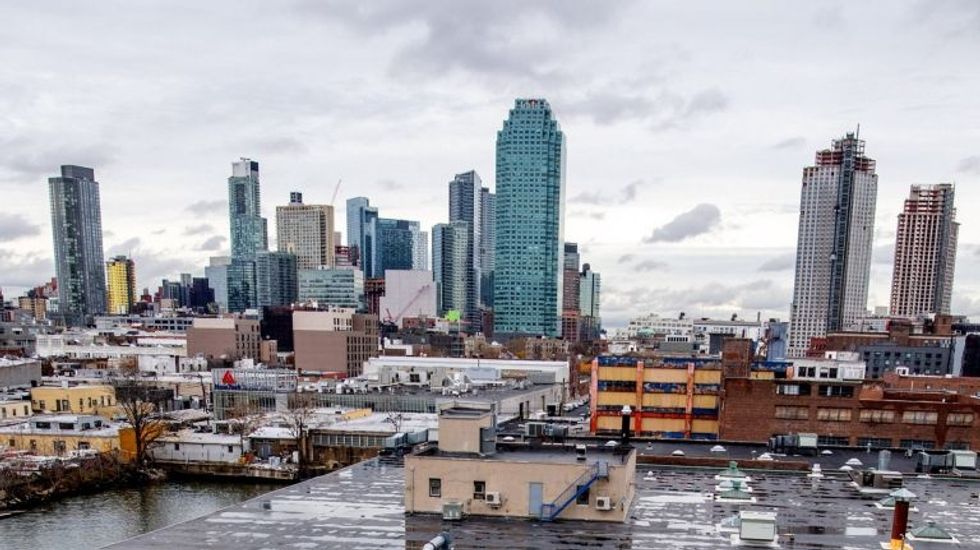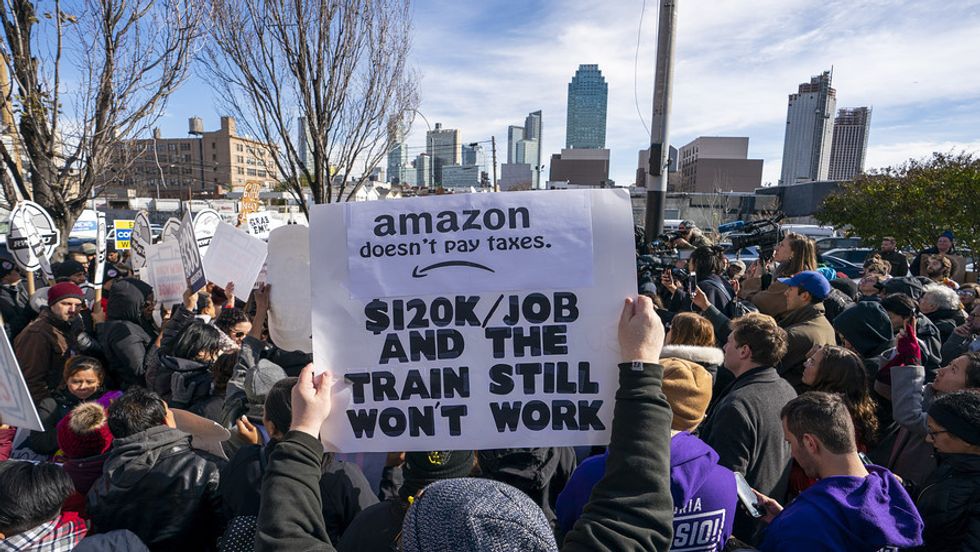The moment Amazon announced that it would be building its second headquarters in NYC’s Long Island City, people took to the streets.
On November 26th, a coalition of immigrant advocates and anti-HQ2 groups gathered to protest Amazon’s involvement with ICE, Paladir, and other organizations responsible for deportations. Citizens marched again on Cyber Monday, launching a ” day of action” and flooding an Amazon Bookstore in Manhattan, holding signs aloft and chanting sing-song rhymes about Jeff Bezos. Together, over two dozen community groups organized these protests, including local unions and nonprofits. Following the protests in Manhattan, Amazon workers employed in warehouses in Staten Island made the decision to unionize, citing low pay and impossible performance quotas, and leveraging Amazon’s impending move to Queens to draw attention to their case.
Their protests attracted the attention of some of New York City’s political officials, such as City Council Speaker Corey Johnson, who initially supported Amazon’s entry but denounced it after learning more about the circumstances surrounding the deal. He began to stand with the protestors, complaining that a general lack of transparency and the fact that Amazon bypassed NYC’s standard review process mandated further investigation.
In December, a public hearing was held at City Hall, and protestors gathered outside while council members grilled economists and officials who had been instrumental in making the deal with the world’s most profitable corporation. “We are not in the business of corporate welfare here at city council,” said Johnson.
It was this so-called corporate welfare—the $3 billion in government and tax incentives that Amazon was promised, in exchange for the 25,000 jobs it promised to create—that became the foundations of the anger stewing around the sales conglomerate’s impending arrival, anger which resulted in Amazon’s decision to pull out of its promise to develop a huge corporate campus in Queens.
 Image via Vox.com
Image via Vox.com
The people’s anger came from different places, and their protests were haphazard efforts, but their rage had been brewing for a long time, and Amazon’s imminent arrival fed a variety of fears about corporate greed and pervasive gentrification, which opponents feared would tear apart places like Long Island City, sucking it clean of culture and community. Amazon’s arrival was predicted to catalyze a wave of homelessness; the announcement that it was setting up shop in Long Island City was instantly followed by dizzying spikes in rent—chilling lower-income residents in a city already plagued by stretches of empty storefronts.
 Long Island CityImage via AM NY
Long Island CityImage via AM NY
Protestors cited Amazon’s effects on Seattle, Amazon’s first home city, as reasons why the conglomerate shouldn’t move on with its plan. Some people argue that Amazon made Seattle into a hull, a kind of paper city that existed only to facilitate its metallic corporate heart; and Seattle’s homeless corporation did rise in tandem with rising housing prices, making it home to the third-highest number of homeless people in the country, after New York and Los Angeles.
HQ2 opposition united a great deal of unlikely allies—including an unlikely ally in the Wall Street Journal’s Editorial Board, who argued that the deal was “crony capitalism at its worst.” Their article continued, “Amazon’s case is aboveboard, but it still amounts to a company with a market capitalization of nearly $800 billion getting paid to create jobs it would have created somewhere anyway.”
Alexandria Ocasio-Cortez was the most visible face of a group of politicians who protested Amazon’s HQ2 establishment, and her resistance might have been one of the central reasons for its decision to abandon ship. “It was that the environment over the course of the past three months had not got any better,” said Joni Seth, Amazon’s head of policy communications. “There were some local and state elected officials who refused to meet with Amazon and criticized us day in and day out about the plan.”
Ocasio-Cortez had long denounced Amazon’s plans to move into Queens, and she celebrated Amazon’s retraction on Twitter. So did other political figures, including Cynthia Nixon. Following the company’s Valentine’s Day breakup announcement, the actress-turned politician triumphantly tweeted, “The fight against Amazon laid bare their union-busting, corporate welfare, ICE-abetting practices and shows why we need to break up monopolies like Amazon.”
In addition to its ties to law enforcement giants, Amazon had also been accused of developing facial recognition technologies to gain information about customers without them knowing; and many protests have cropped up among its warehouse workers, especially in Europe, where employees have staged walkouts against low wages and poor working conditions.
 A protestor stops an Amazon truck in Spain.Image via apnews.com
A protestor stops an Amazon truck in Spain.Image via apnews.com
Despite Amazon’s shady ethics, many people were not as enthusiastic about the company’s foiled New York City dreams, arguing that the demise of HQ2 will compromise what could’ve been an economic boom for the city, criticizing Ocasio-Cortez’s decision to favor ideology over economics. Amazon may have hiked up rents, but rents are high anyway; and its arrival would have created thousands of jobs, including consistent positions for lower-level staff members and service workers.
Plus polls showed that 56% of New Yorkers approved Amazon’s arrival, which was initially billed as a triumph by Mayor Bill de Blasio and Governor Andrew Cuomo—both central players in the deal’s initial success who believed that the arrival would help NYC solidify its position as a worldwide hub of tech and industry. Bill DeBlasio’s tweets following Amazon’s decision resembled those of a spurned ex. He also lashed out at Ocasio-Cortez, stating that “a small group of politicians put their own narrow political interests above their community—which poll after poll showed overwhelmingly supported bringing Amazon to Long Island City—the state’s economic future and the best interests of the people of this state,” the governor said in a statement.
But even so, a great deal of major political figures opposed the deal, including Senator Michael Gianaris of Queens, who initially supported Amazon’s arrival but, like Johnson, changed his mind after learning about its policies. Still, Amazon in Long Island City’s demise all started with those first street protests, which erupted directly after De Blasio’s announcement as politicians remained silent. Ultimately, community members and citizen organizers catalyzed the start of the resistance that led to the downfall of Amazon’s Queens campus.
 Image via Marketwatch
Image via Marketwatch
There’s something deeply satisfying about the image of the world’s richest man and his behemothic corporation getting kicked out of New York by impassioned Queens residents, ready to unite and fight for the integrity of their home borough. Still, Amazon’s departure won’t stop gentrification, won’t fill up empty stores, and won’t bring back the days when young artists could gallivant around Greenwich Village with pennies in their pockets and working-class families could call Manhattan home.
In a way, Amazon’s departure is a symbolic victory for its opposition, a tantalizing promise that the people can triumph over corporations. Of course, this move will not deter Amazon from building its global empire, and America’s supermassive wealth gap will remain. It just won’t be as tangibly visible in New York.
Eden Arielle Gordon is a writer and musician from New York. Follow her on Twitter at @edenarielmusic.
- How Amazon blew its chance in New York – CNN ›
- Montreal fails to make shortlist of cities vying for Amazon’s 2nd … ›
- Baltimore unveils failed bid to lure Amazon headquarters – Baltimore … ›
- Las Vegas fails to make the cut for Amazon headquarters | Las … ›
- Amazon recasts for alternative headquarters if New York site fails ›





